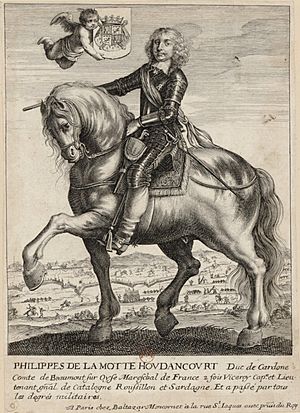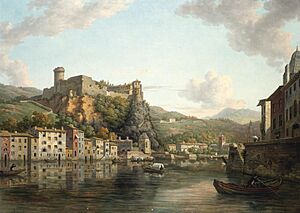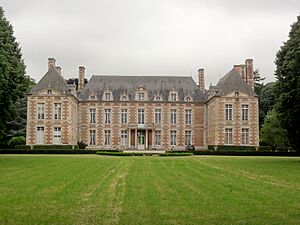Philippe de La Mothe-Houdancourt facts for kids
Quick facts for kids
Marshall Philippe de La Mothe-Houdancourt
|
|
|---|---|

Marshall Philippe de La Mothe-Houdancourt
|
|
| Born | 1605 |
| Died | 24 March 1657 (aged 51–52) Le Fayel, Kingdom of France |
| Allegiance | |
| Years of service | 1622–1652 |
| Rank | Marshal of France |
| Commands held | French Viceroy of Catalonia, 1642–1645, 1651–1652 |
| Battles/wars | Huguenot rebellions La Rochelle; Saint-Martin-de-Ré War of the Mantuan Succession Castelnaudary Franco-Spanish War (1635-1659) Les Avins; Leuven; Turin; Catalan Revolt Montmeló; Lleida (1642); Lleida (1644); Barcelona (1651) |
Philippe, Count of La Mothe-Houdancourt (born 1605 – died 24 March 1657) was a French soldier. He became a Marshal of France, which was a very high military rank. He also served as the French leader, or Viceroy of Catalonia, when France controlled that area during the war with Spain.
In 1642, he received a Spanish title, Duke of Cardona, but this was not widely accepted. Later, in November 1644, he was arrested and held in prison for four years. After his release, he joined a rebellion against the king called the Fronde in 1648. However, he changed sides in 1651 and was again made Viceroy of Catalonia.
After losing the city of Barcelona in 1652, he stopped his military career. He passed away in 1657.
Life and Family
Philippe de la Mothe-Houdancourt was born in 1605. His father, also named Philippe, lived to be 94 years old. Philippe was the oldest of eleven children from his father's third marriage. His full brothers were Daniel and Henri. He also had an older half-brother named Antoine.
In 1650, Philippe married Louise de Prie. They had three daughters: Françoise Angélique, Éléonore Madeleine (known as Charlotte), and Marie Gabrielle Angélique.
His daughter Charlotte later married the Duke of Ventadour. She became the governess for Louis XV of France, who was only five years old when he became king in 1715. It is said that Charlotte saved the young king's life. She stopped doctors from bleeding him, a common but dangerous medical practice at the time. This procedure had already caused the death of Louis XV's older brother.
Military Career
Philippe began his military career at age 17 in 1622. He fought in the Huguenot rebellions, which were conflicts in France. He took part in the sieges of La Rochelle and Saint-Martin-de-Ré in 1629. He also fought in the War of the Mantuan Succession from 1628 to 1631.
In 1632, he helped the king's forces stop a rebellion at the Battle of Castelnaudary. That same year, he became the governor of Bellegarde.
When the Franco-Spanish War started in May 1635, Philippe led his own regiment. He fought in battles like Les Avins and the Siege of Leuven. In 1636, he was in charge of the soldiers at Saint-Jean-de-Losne. He defended the city against attacks until help arrived.
He was promoted to lieutenant general in 1640. He then served in Piedmont, helping to capture Casale Monferrato and Turin in 1640.
Philippe's career was helped by his family connections to Cardinal Richelieu, a powerful French minister. He also had support from François de Noyers, the Secretary of War. In January 1642, he took command of French forces helping the Catalan Revolt. He won important battles at Montmeló and Lleida.
Because of his successes, he was made Viceroy of Catalonia and a Marshal of France. He also received the title of Duke of Cardona. However, the death of Cardinal Richelieu in December 1642 caused Philippe to lose his important supporters.
Challenges and Later Years
King Louis XIII died in May 1643. His five-year-old son, Louis XIV, became king. A group led by his mother, Anne of Austria, and Cardinal Mazarin, ruled France. This led to power struggles with powerful nobles like Condé.
By 1644, Spain was winning back land in Catalonia. After Philippe surrendered Lleida in July, he faced serious accusations. These accusations were linked to a political disagreement from 1643. This disagreement involved powerful nobles who wanted more say in how the country was run. They believed the war with Spain was being continued on purpose by the king's advisors.
Philippe was ordered back to France in November 1644. When he arrived in Lyons, he was arrested and held in the Pierre-Size fortress for four years.
After his release in 1648, Philippe first supported the Fronde. This was a time of unrest and rebellion against the king's government. He later decided to support the king in 1650. In 1651, he was again made Viceroy of Catalonia. However, he had to surrender Barcelona in October 1652.
After this, he retired from active service. He went to his family's estates at Le Fayel. There, he oversaw the building of Château du Fayel. The castle was finished shortly before he died in 1657. The building is still largely the same today and is privately owned.
See also
 In Spanish: Philippe de La Mothe-Houdancourt para niños
In Spanish: Philippe de La Mothe-Houdancourt para niños




